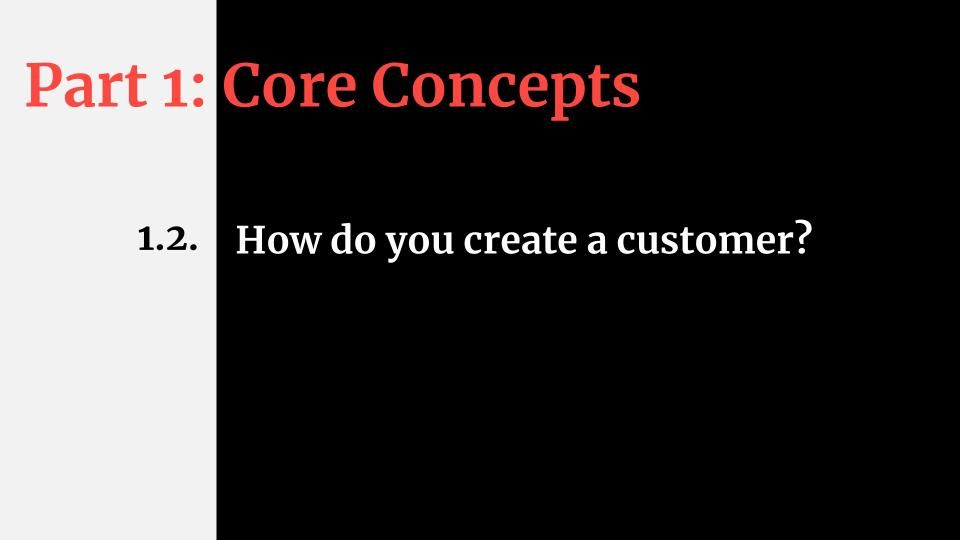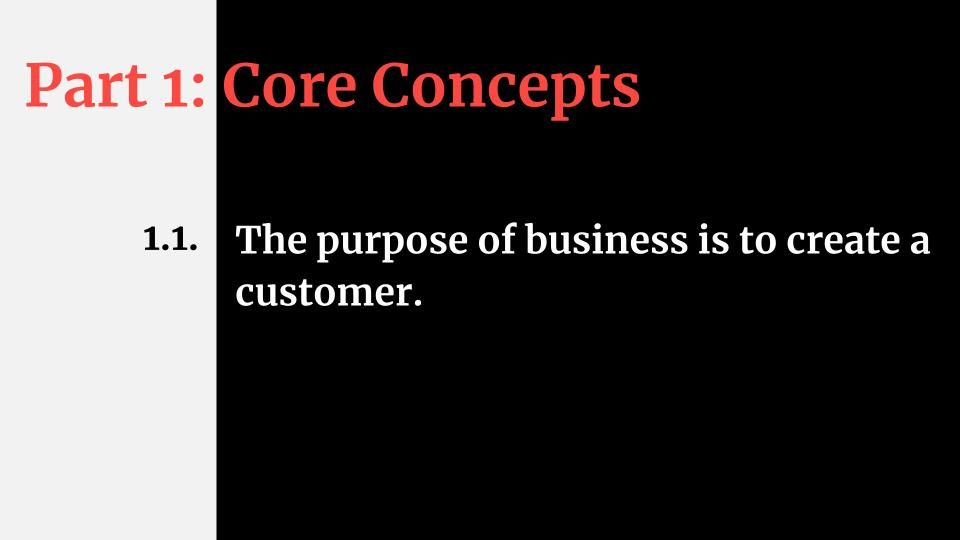1.2. How do you create a customer?

What does it mean to create a customer? A better question: How do you create a customer? To create a customer means to identify the need, create the demand in the market, and design a product or service that fulfills this demand. Ultimately, the customer determines the value of the product or services and as a result the profitability of a company. Customers vote with their money.
Attention is a valuable currency as well. Some of the most successful companies in the last decades were built on aggregating the attention of a large number of people — Google and Facebook, to name a couple of examples. Attention is easy to monetize. So spending time on a particular resource, platform, or tool is an act of voting and it's as good or in some cases even better than a monetary transaction. We provide a ton of our personal data when we use Facebook. And the more Facebook knows about us the more targeted are the ads they can sell. In a physical world, it's much more difficult to estimate customer buying power or intent.
Starting a new company is hard in part because it's difficult to convince a large enough group of people to buy a new product or capture their eyeballs. Creating customers means creating demand. While your customers can experience the pain it doesn’t necessarily mean that demand exists on the market. The crucial distinction between customer pain and demand is that even if customers understand the pain they might not have a clear idea of how to solve this problem and with what product.
Market demand implies that the customer understands exactly what they need to solve a problem. You can even say that demand exists on the market when a customer demands a solution for a problem.
By definition, every truly new market has zero demand. The history of evolution for products and markets that have been around for a while can provide great insight. When Henry Ford started selling his Model T to the masses many, if not everyone, understood the pain of getting from one destination to another. However, not many viewed cars as a solution to this problem. There was no demand for cars. What Henry Ford did and what every startup founder hopes to do since it is to blend an idea of pain or desire with a solution by educating potential customers on how it can improve their lives or make them happier.
Customer education is the main challenge that a company entering the market or creating a category faces (more on this later). Educating customers is an essential part of demand creation. It is not about pleasing customers using any tactics possible. It is not about blindly implementing every customer request. It is about understanding customer pains, needs, and desires and educating them on how to reach the desired outcome. Empathy plays an important role in understanding people you are trying to serve.
Not every pain, need, or desire has an economically valuable solution. It's possible that the solution production cost is higher than the pain it solves. Over time this may change, which is why you hear a lot about the right timing in the startup world. Technology and market forces can change rapidly to enable solutions that previously weren't economically viable compared to the problem they solved.
For example, many entrepreneurs recognized that managing bookmarks in your browser is messy and convoluted. There were hundreds of startups trying to build products to help people manage bookmarks and save links in a more productive way. Most of them failed because the pain that they were trying to alleviate was big enough and potential customers already had their own systems in place. Over the years, people found their own system of capturing links and resources and categorizing them. Furthermore, the size of the customer segment that would be willing to pay for a solution was small. Not every problem is big enough and economically valuable enough to require a solution.
It’s widely accepted that Reed Hastings, CEO and Founder of Netflix, envisioned a streaming service back in the late 90s. However, the technology and infrastructure were not ready to transmit video entertainment via the web. The genius of the Netflix team is that they figured out the stepping stones in the middle before the larger vision was valuable from an economic and technical perspective. Netflix offered DVD rentals and built a loyal customer base starting in 1998. And only 9 years later in 2007 technology caught up to implement their vision and a streaming service was launched.
That’s why startups are so difficult. They have to create a customer, which means creating a non-existing demand by matching customer needs and wants with the product capabilities. The customer might not be aware of the need or want that they have until products or services are introduced to the market. Who knew we needed a better way to connect with friends before Facebook came along? Was anyone looking for a better work communication tool before Slack came along? Do you know anyone who was asking how to share what they had for lunch in 140 characters before Twitter? It's highly doubtful.
Often we don't know what we need or want as customers but we definitely know whether we want something or not when we see it. And asking customers about what they want won't necessarily get you anywhere close to building a financially successful product. As a marketer, founder, or business person it's your job to understand customers well enough to come up with a solution that will be valuable to them.
To create a customer means to find a need or want and figure out a way to satisfy it with a new product, business model, service or all of them at once. The important caveat, however, is that customer desires (needs or wants) need to be addressed at costs below the value the customer is willing to pay. In order to build a sustainable long-term business, the value put into product innovation and marketing needs to be lower than the value that the customer gets out of the product or services.
The fact that there are many people that experience similar pain, need, or desire doesn't mean that there is a demand for a specific solution. Quite often, you can hear startups equating pain to market demand. The logic of a founder who says that demand exists because there are many who experience this problem is misleading. Demand exists when people know or are actively looking for an exact solution. The gap between pains, needs, and desires is bridged with customer education.
The customer comes before the profit. Often organizations make decisions that benefit the company and not the customer. Many of us, I'm sure, sat in meetings discussing sales, marketing, or product strategies only to realize that we are no longer focused on our customers. Let's add a question to the lead form asking what industry or country the prospect is coming from. It will help us route the right leads to the right team and salesperson. Sure, but will it help prospects in any way? The answer is most likely not.
The perfect illustration of how we don’t always have our customers in mind when we develop product or marketing campaigns is the rise of lead generation forms in the early 2000s to gate our marketing content. Imagine someone asking you to provide your name and phone number in order to enter a retail store. That sounds wild and crazy but this is exactly what we have been doing in the last couple of decades when it comes to marketing software.
What’s even worse, we have built a whole marketing automation industry to help us nurture, score, and filter customers while sending them tons of emails. Instead of providing our content for free and educating our customers and encouraging them to share our point of view, we block them from consuming our content. It is difficult enough to get the attention of anyone in a sea of distractions and limitless amounts of free content. Proactively gating your own content limits its reach and educational impact on the marketplace.
Market demand is created through education, and the more effort it takes the customer to access your resources the harder it is to generate market demand. It’s no surprise that a large portion of the data that marketers get from long lead generation forms is bogus or incorrect. You haven't provided customers with any helpful information but you are already asking them to share their contacts.
But did you know that in the golden age of retail in the early 20th century, stores didn't display prices? Even more, retail stores didn't display their products in the window--they wanted customers to come in and ask to see their assortment. A salesperson would look at potential customers and assess their social status. Then they would bring a piece of clothing and make up the price according to their guess of the buyer's wealth. So one buyer could be given a price of $5 and another could hear the price of $25 for the same item. Today this approach sounds strange but that's exactly how it worked.
The software industry is only a few decades old. We can draw parallels between retail a century ago and software in the last decades. In both instances, companies created a barrier for customers to see and try the product. Marketing and sales in SaaS and enterprise often work the same way or even worse. Just imagine that in order to enter the store or get a marketing brochure you have to share your personal contact information. This doesn't sound very enticing to customers.
First, a company creates customers and then how well it's done can be measured with revenue and profit. In his famous speech, David Packard, co-founder and CEO of HP, said that none of the company's objectives can be accomplished unless the company makes a profit (source The HP Way). Profit, according to Packard, is the measure of the contribution to the customer -- it is a measure of what customers are willing to pay over and above the actual cost of a product.
Checkout my course on How to Conduct Customer Interviews
Read the previous chapter


